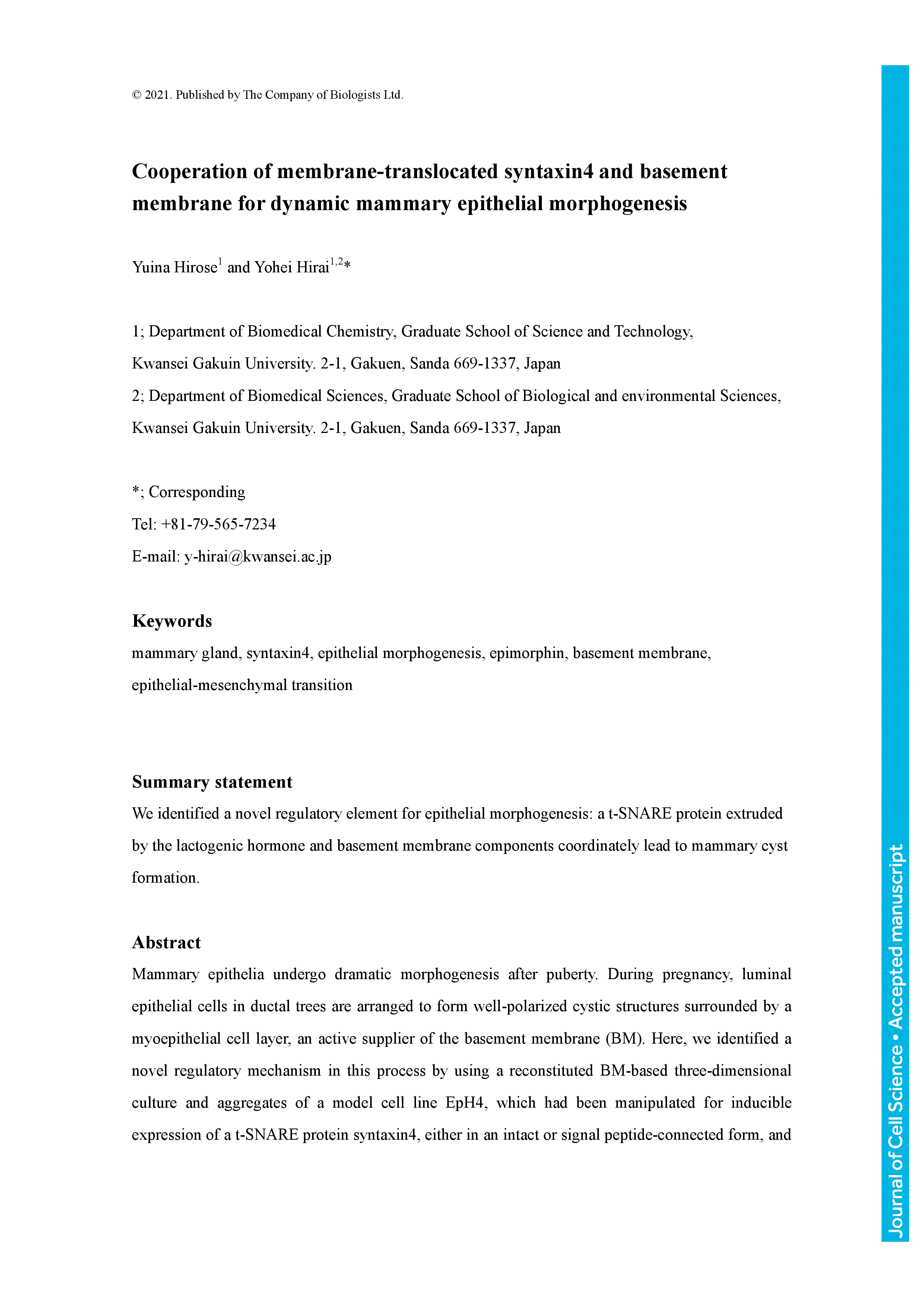Mammary epithelia undergo dramatic morphogenesis after puberty. During pregnancy, luminal epithelial cells in ductal trees are arranged to form well-polarized cystic structures surrounded by a myoepithelial cell layer, an active supplier of the basement membrane (BM). Here, we identified a novel regulatory mechanism in this process by using a reconstituted BM-based three-dimensional culture and aggregates of a model cell line EpH4, which had been manipulated for inducible expression of a t-SNARE protein syntaxin4, either in an intact or signal peptide-connected form, and those genetically deficient in syntaxin4. We found that cells extruded syntaxin4 upon stimulation with the lactogenic hormone, prolactin, which in turn accelerated the turnover of E-cadherin. In response to extracellular expression of syntaxin4, cell populations that were less affected by BM actively migrated and integrated into the BM-faced cell layer. Concurrently, the BM-faced cells, which were simultaneously stimulated with syntaxin4 and BM, acquired unique epithelial characteristics to undergo dramatic cellular arrangement for cyst formation. These results highlight the importance of the concerted action of extracellular syntaxin4 extruded by the lactogenic hormone and BM components in epithelial morphogenesis.
ACCEPTED MANUSCRIPT
RESEARCH ARTICLE|
22 October 2021
Cooperation of membrane-translocated syntaxin4 and basement membrane for dynamic mammary epithelial morphogenesis
In collection:
Polarity
Yuina Hirose,
Yuina Hirose
1
Department of Biomedical Chemistry, Graduate School of Science and Technology, Kwansei Gakuin University. 2-1, Gakuen, Sanda 669-1337
, Japan
Search for other works by this author on:
Yohei Hirai
Yohei Hirai
*
1
Department of Biomedical Chemistry, Graduate School of Science and Technology, Kwansei Gakuin University. 2-1, Gakuen, Sanda 669-1337
, Japan
2
Department of Biomedical Sciences, Graduate School of Biological and environmental Sciences, Kwansei Gakuin University. 2-1, Gakuen, Sanda 669-1337
, Japan
*Author for correspondence: y-hirai@kwansei.ac.jp
Search for other works by this author on:
Yuina Hirose
1
Department of Biomedical Chemistry, Graduate School of Science and Technology, Kwansei Gakuin University. 2-1, Gakuen, Sanda 669-1337
, Japan
Yohei Hirai
*
1
Department of Biomedical Chemistry, Graduate School of Science and Technology, Kwansei Gakuin University. 2-1, Gakuen, Sanda 669-1337
, Japan
2
Department of Biomedical Sciences, Graduate School of Biological and environmental Sciences, Kwansei Gakuin University. 2-1, Gakuen, Sanda 669-1337
, Japan
*Author for correspondence: y-hirai@kwansei.ac.jp
Received:
13 May 2021
Accepted:
18 Oct 2021
Online ISSN: 1477-9137
Print ISSN: 0021-9533
Funding
Funding Group:
- Award Group:
- Funder(s): Japan Societty for the promotion of Science
- Award Id(s): 19J22142
- Funder(s):
Funding Group:
- Award Group:
- Funder(s): KG special Research Fund
- Award Id(s): 167AB0177a
- Funder(s):
J Cell Sci jcs.258905.
Article history
Received:
13 May 2021
Accepted:
18 Oct 2021
Currently Viewing Accepted Manuscript - Newer Version Available
23 Nov 2021
- Standard view
- Views Icon Views
- Open the PDF for in another window
-
Article Versions Icon
Versions
- Version of Record 23 November 2021
- Accepted Manuscript 22 October 2021
- Share Icon Share
-
Tools Icon
Tools
- Search Site
Citation
Yuina Hirose, Yohei Hirai; Cooperation of membrane-translocated syntaxin4 and basement membrane for dynamic mammary epithelial morphogenesis. J Cell Sci 2021; jcs.258905. doi: https://doi.org/10.1242/jcs.258905
Download citation file:








